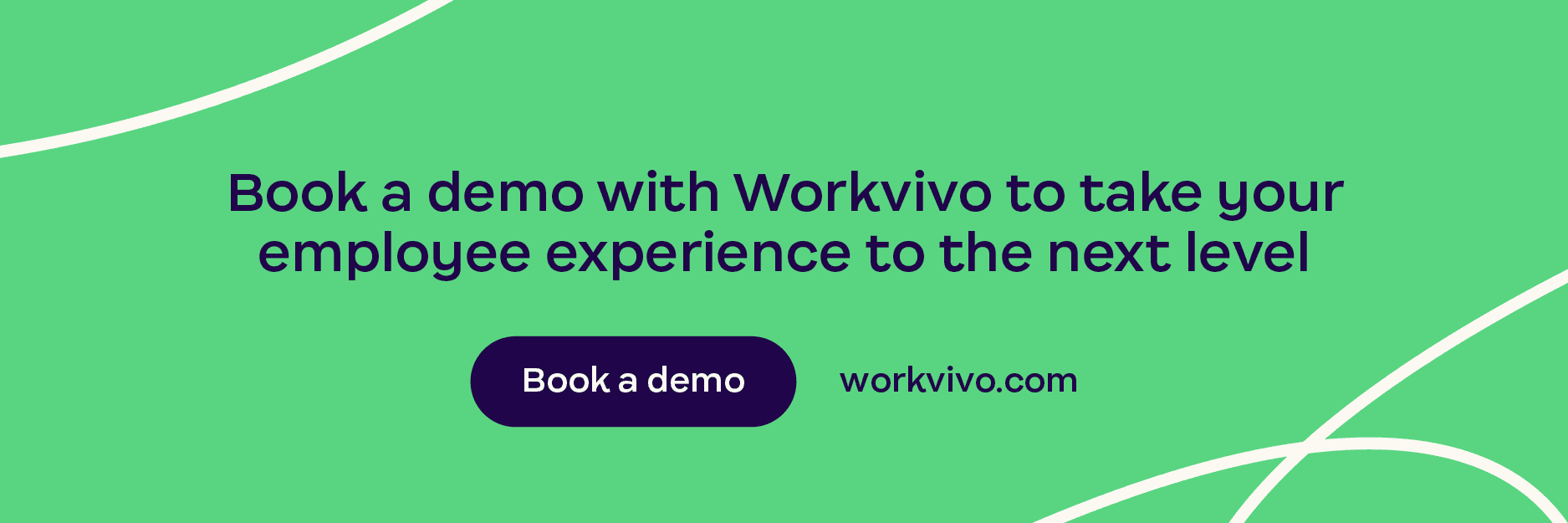What Is An Employee App? (And Why You Need One)

Richard Barrett
Director of Marketing
October 12 2023

The way we work has changed drastically since 2019 – and there’s no going back. While there are plenty of advantages to our new working habits, it’s not exactly a utopia.
Many employees report enjoying working from home, and yet burnout remains at an all-time high, with almost 50% of respondents in one research survey experiencing burnout symptoms regardless of where they work.
Plus, up to 36% of those working from home reported to Pew that remote work hurt their opportunities to be mentored and how connected they feel to their coworkers.
Remote and hybrid work is here to stay, and despite the benefits, it’s messing with employee communication and relationships.
One solution: an employee app.
Not sure what that is or why you need one? We’ve got answers below.
What is an employee app?
An employee app is any tool or platform that’s designed to make work easier. There are many different apps available, from simple real-time internal communication tools to apps offering easier project collaboration.
We’ll cover some of the main types of employee apps available (with examples) further on.
Using an employee app, you can give your team on-demand access to personalized, relevant, and useful information they need to do their jobs. You can also create a digital space where staff can communicate openly, collaborate effectively, and even build workplace relationships – wherever they are.
5 reasons your company needs an employee app for internal communications
We know employees are already using their smartphones at work. So, why not meet them where they already are, and offer useful information, communication tools, and updates on an app they can access right from their phones?
Using an employee app for internal comms unlocks significant benefits for your company. Consider these five ways an employee app can help.
1. Communicate more effectively with your entire workforce
The last several years have seen a significant percentage of the information workforce move to remote or hybrid work. And it’s clear that traditional communication methods are not fit for this new world.
Apps can replace – and work alongside – the methods of employee communication you already use. For example, Workvivo offers integrations with workplace communication tools such as Slack and Microsoft Teams, so your team can communicate in real time, all in one place.
2. Bring more attention to your internal communications
If your business has a defined internal communications strategy, you’re already ahead of many others. But one of the biggest challenges internal comms professionals face is getting people to actually read their emails.
By consolidating your internal communications in one location – ideally one with a familiar and engaging interface that your employees actually want to use – you can get more eyes on your content and make sure everyone has access to the information they need.
Workvivo is the employee communication app that gives everyone a voice – and that helps businesses bring more attention and focus to their internal comms.
3. Boost engagement and increase employee productivity and staff retention
Poor communication can lead to low employee engagement. There’s usually an obvious direct link between low engagement and other undesirable outcomes like low productivity and high employee turnover.
Employee engagement is driven by many factors, including some of the pain points exacerbated by the recent shift to remote and hybrid work.
Gallup’s Q12 survey also identifies employees knowing what is expected of them, having the materials they need to do their job, receiving employee recognition and praise, and feeling that their opinions count as key drivers – all of which can be achieved with an employee engagement app like Workvivo.
4. Build an open and accountable company culture
There’s a real need for openness and accountability in business today.
According to Gallup data, only 13% of employees felt that their company’s senior leadership was effectively communicating with the rest of the organization. And, according to IBM, 72% do not fully understand their company’s strategy.
This is in spite of the fact that transparency and open workplace communication can lead to higher employee productivity, lower turnover, and increased engagement: Forbes says that transparency and trust are far more important for company culture than flashy perks.
By using an employee app and an effective modern social intranet to talk openly and regularly with employees, company leaders can create a transparent (and more productive) work environment for everyone.
5. Access valuable data and insights
Accurate data is one of the best tools internal comms teams, HR professionals, and company leaders have at their disposal – but only if they know how to use it.
Well-built employee apps can give leaders access to numbers and insights about what content staff is interacting with, so you can easily see what really matters to your team.
In turn, this allows you to make strategic decisions about the communications you share.
Also, remember that everyone is different. Good employee apps will allow you to personalize content for different groups, team members, and departments according to what resonates with them.
What makes a good employee app?
There are a lot of employee apps out there, and the choice you make will likely depend on the size of your company, the industry you’re working in, and multiple other factors.
But you do need to make sure you choose one that:
- Is easy to use
- Meets your specific company needs
- Your staff actually wants to use
Below are some important features to look for in a good employee app.
A mobile-friendly platform
Mobile phones now account for over half of all global web traffic, and 97% of Americans own a mobile device. These days, a platform that only works on a desktop computer just isn’t enough – especially with more and more companies transitioning to remote or hybrid work. A mobile solution is critical.
Having an employee mobile app that’s available on their phones is also a huge benefit to the global workforce classified as non-desk workers or frontline employees. These folks have suffered for years from not having the same easy access to company information as their office-based colleagues.
Workvivo is the perfect solution here: with native mobile apps for both Apple’s iOS and Google’s Android, every smartphone user can access Workvivo in a native mobile format.
Pulse survey and polls
Ever wonder what your employees really think? Apps that include survey and poll functionality can help you to find out by giving you an insight into how your teams are feeling.
Employee pulse surveys and polls are a great way to:
- Gather opinions on new policies
- Get a feeling for employee morale
- Make sure you’re aware of any problems your team encounters
To ensure everyone feels comfortable answering honestly and openly, it’s a good idea to set up surveys so staff can respond anonymously.
Collaboration and knowledge-sharing tools
One of the great advantages of using employee apps is that they allow teams to collaborate on projects, even when they’re not working in the same place. They also greatly enhance the employee experience.
Many apps come with knowledge-sharing tools that allow you to pool the documents, files, and corporate resources your team needs in one place. Others may have group functions, where teams who are collaborating on projects can share progress, ask questions, and work together effectively.
Because Workvivo is an employee app and social intranet all in one, it’s the perfect platform for knowledge sharing.
Push notifications
Sometimes you need to get a message out to your employees – and know they’ve received it. A push notification is great for this.
This could be to let them know about important business updates or even share urgent company information, such as office closures or severe weather warnings. Push notifications can also be used effectively to communicate with frontline employees/workers.
Many employee apps – Workvivo included – can send push notifications, allowing you to send notifications directly to your employees’ phones.
Fully-branded environment
No two companies are the same; the employee app you use should reflect the values, mission, and branding of your organization.
It’s also important that your app is consistent with the internal comms you’re already doing so it feels familiar to your employees.
Look for apps that are customizable and can incorporate your branding – including logos, color, and typefaces – so your staff will feel at home straight away and enjoy a strong employee experience.
People directory
Employees in large organizations often have trouble figuring out the right person to contact – a problem that has become even more apparent now that so many of us have barely met our colleagues face-to-face.
Workvivo includes an integrated people directory, providing profile information on each employee. This can help them understand who is responsible for what – and even get to know each other thanks to Workvivo’s social components.
Make sure to choose an app with a user-friendly people directory so employees can quickly find the person they need.
A familiar interface
We all have a lot on our minds in today’s fast-paced business environment – and the number of different tools, technologies, and platforms we have to navigate seems to increase each year.
Trying to introduce an employee app with a confusing interface and steep learning curve will likely fail – because your team probably just won’t use it.
Instead, look for tools that feel familiar and that have been built with ease of use and simplicity in mind.
Social features
Lastly, look for an employee app that’s full of helpful social features, like posts, shout-outs, likes, and comments. These kinds of tools make the most sense when your app is linked to an internal social network or social intranet.
Workvivo’s social intranet is the ideal way to incorporate social features like these into your professional setting. Workvivo keeps things professional while also encouraging positive social interactions centered on work and benchmark achievements.
Types of employee app (with examples)
There are many different types of employee apps on the market, which all have different functionalities. It’s important to choose the right platform for your company based on what you hope to get out of it.
Below are a few examples of the types of apps available.
Employee communication apps
These apps help employees to communicate with each other remotely. In fact, there’s a good chance your company is already using at least one of them. They may include chat functions, collaboration and project management tools, and video conferencing.
Examples: Slack, Zoom, Skype, MS Teams, Google Meet, Trello, Jira
Employee development apps
Most organizations who know what they’re doing have some kind of employee development program in place – and employee apps can help. Many of them allow employees to take short courses and learn new skills (and brush up on old ones, too). They can also be very useful for employee onboarding, as they can assist new hires in quickly getting up to speed.
Examples: LinkedIn Learning, Udemy, Moodle, BetterUp, Skill Pill
Employee engagement apps
An employee engagement app helps them feel more satisfied with their work. There are many different employee engagement tools available.
Their functions might include pulse surveys and polls to help human resources and management understand their employees, especially frontline workers. Choose an employee engagement app that best suits your needs.
Examples: Culture Amp, TINYPulse, Workvivo
Employee evaluation apps
Tracking performance and progress is an important part of any business, allowing leaders to conduct reviews, identify problems, and help their teams succeed.
Employee evaluation apps can help by providing tools for staff to self-evaluate, as well as allowing managers and other employees to give praise and recognition when a job is done well.
Examples: Lattice, PerformYard Talent, Trakstar, Sage HR
Employee portal apps
Employee portal apps are designed to give a company’s entire workforce (including frontline employees) on-demand and instant access to all the practical company information they need, from payroll to vacation calendars to the structure of the organization.
Employees benefit from having everything in one easy-to-access location.
Examples: Zenefits, Smartsheet, Jostle, Boardable
Check out the all-of-the-above employee app with Workvivo
Workvivo is the leading employee app, one that combines all of the benefits above in one central hub. This streamlines internal employee communication and allows workers at all levels to build deeper connections with less noise – all on a user-friendly interface that your team will actually use.
Workvivo replaces your company intranet, plus it’s also your new internal comms tool, employee directory, and employee app – all combined into one friendly and familiar social employee experience on your mobile device and desktop. We are not just another intranet platform.
Additionally, Workvivo integrates with many of the tools you’re probably already using, including Slack, MS Teams, Zoom, Salesforce, and more.
Workvivo helps employees thrive and helps leaders ensure their entire workforce is happy, engaged, and productive – without the need to chase up emails or the distraction of a constantly pinging Slack channel.
Interested? Schedule a personalized Workvivo demo to learn more.!
